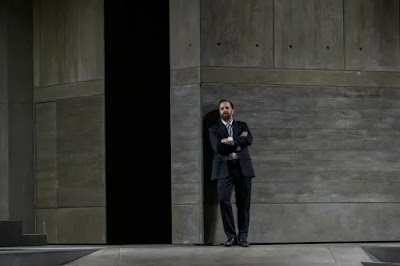 |
| Mozart: Don Giovanni - Etienne Dupuis, Philippe Sly - Paris Opera (Photo Charles Duprat / OnP) |
Reviewed by Robert Hugill on 11 July 2019 Star rating: (★★★★)
A stylish contemporary take, which stays true to Mozart and Da Ponte's drama and provides some tautly dramatic moments
What happens when you bring a contemporary Belgian theatre director, known for challenging audiences, together with Mozart's Don Giovanni?
 |
| Mozart: Don Giovanni - Etienne Dupuis, - Paris Opera (Photo Charles Duprat / OnP) |
Ivo van Hove's Avignon festival production of Les Damnés (The Damned) for the Comédie-Française (which was recently seen to some acclaim in London) featured male and female nudity and implied paedophilia. Mozart's operatic masterpiece would seem to offer great scope, then for a free reign of the imagination.
In fact, Ivo van Hove's new production of Mozart's Don Giovanni at the Paris Opera's Palais Garnier (seen 10 July 2019) proved to be a thoughtful and tightly plotted production which stayed close to Mozart and Da Ponte without being over reverent. Designs were by Jan Versweyveld with costumes by An D'Huys, choreography by Isabelle Horovitz and video by Christopher Ash. Philippe Jordan conducted with Etienne Dupuis as Don Giovanni, Ain Anger as the Commendatore, Jacquelyn Wagner as Donna Anna, Stanislas de Barbeyrac as Don Ottavio, Nicole Car as Donna Elvira, Philippe Sly as Leporello, Mikhail Timoshenko as Masetto and Elsa Dreisig as Zerlina.
Versweyveld's stylish grey set echoed Escher, Piranesi and those designs of ideal Renaissance cities, but here one re-made in 1970s cast concrete, the result was to evoke the great Italian architect Carlo Scarpa. Within this, D'Huys' costumes were roughly contemporary, with clear delineation of hierarchy and class, that this opera opera needs. Jan Versweyveld's lighting was highly effective, often from within the rooms of the set. With the gloom and faces in shadow for the opening scene making credible Donna Anna's claim that she did not see the face of her attacker.
 |
| Mozart: Don Giovanni - Elena Dresig, Mikhail Timoshenko, Nicole Car, Philippe Sly, Stanislas de Barbeyrac, Jacquelyn Wagner - Paris Opera (Photo Charles Duprat / OnP) |
Etienne Dupuis's rather dubious, gun carrying Don Giovanni and Philippe Sly's Leporello were dressed similarly, with similar beards, so that Leporello was less Don Giovanni's servant than his protegee. Etienne Dupuis's portrayal of Giovanni was more fully rounded than some recent performances that I have seen. There was clearly a vein of great anger and cruelty running through him, with an expectation of being obeyed, yet he was capable of great charm, suaveness and sexual magnetism, you could understand why he succeeded in all those seductions. But what Dupuis let you see was that this was a facade, and the man was deeply flawed with the final banquet demonstrating the sheer grossness of Giovanni's appetites.
The re-focusing of Don Giovanni and Leporello's relationship helped us understand why Leporello stayed with his master in a modern servant-less age. Leporello wants to be Don Giovanni. Philippe Sly was in the vein of fierce Leporellos which seem to be the vogue at the moment. His asides were less comic comments to the audience than his own rumbling commentary on his master's behaviour. But Philippe Sly was funny too, and with a strong physicality which really marked out the portrayal. 'Madamina' had a strength to it which was striking. The swapping of identities in Act Two was neatly and believably done.
Nicole Car sang Donna Elvira with great intensity, a highly concentrated performance which brought out the character's neuroticism, and with a dramatic sense which, using the fuller Vienna version of the role, pushed Donna Elvira closer to Donna Anna. But the tenderness and powerful sense of loss which Car brought to the role created something rather remarkable and compelling.
 |
| Mozart: Don Giovanni - Jacquelyn Wagner, Etienne Dupuis, Ain Anger, Philippe Sly Paris Opera (Photo Charles Duprat / OnP) |
Stanislas de Barbeyrac was a highly dramatic Don Ottavio, making the character seem more involved in the action. He sang both the arias, and in both had a tendency to shape the music for dramatic purposes to the detriment of the musical line.
Elsa Dreisig's Zerlina was youthful and charming, deferential to Dupuis's Don Giovanni yet sure of her own worth. The way she seemed to play Mikhail Timoshenko's Masetto off against Don Giovanni made you sense that Zerlina and Masetto's relationship would always be complex. Timoshenko was an appealing Masetto, his rough diamond charm making up for his rough manners. The cast was completed by Ain Anger's quite youthful Commendatore, who thundered impressively.
 |
| Mozart: Don Giovanni - Philippe Sly, Nicole Car - Paris Opera (Photo Charles Duprat / OnP) |
The scene between the Commendatore and Don Giovanni was the tensest and most powerful I have seen in a long time. The Commendatore's urgings of Don Giovanni to repent really meant something as did Don Giovanni's repeated denials. That was a real tussle, and at the end Don Giovanni disappeared after the Commendatore into the fires of Hell (well smoke actually).
For the final ensemble, the city-scape returned but transformed with awnings, plants and washing drying into a more naturalistic, real setting. Life gets back to normal.
In the pit, the orchestra was raised very high, we could see and hear them well and Philippe Jordan brought all sorts of details out which can sometimes get lost in large scale performances. This was, on the whole, a fast, lithe account of the work with the Paris Opera orchestra showing its mettle whilst never being afraid of not being HIP. Jordan provided the forte-piano continuo and I sometimes found his figurations somewhat over elaborate.
 |
| Mozart: Don Giovanni - Paris Opera (Photo Charles Duprat / OnP) |









,%20Giorgio%20Vasari,%20Palazzo%20Vecchio,%20Florence.jpg)

No comments:
Post a Comment